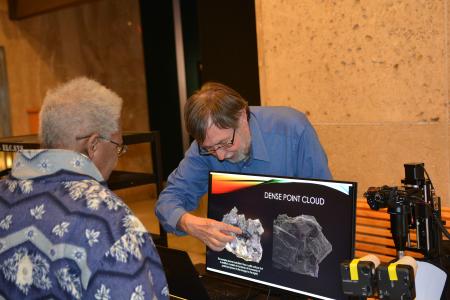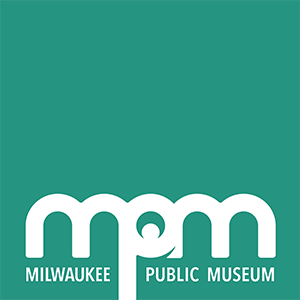This spring, our most popular member event returns!
 Date and Time
Date and Time
Friday, April 11, 2025
6 – 9 p.m.
Cost
Free members-only event; limited capacity
Sustainer and Donor level members are allowed two guests not covered by your membership for free!
Reservations
This event has passed, click here to see other upcoming events at MPM.
Reservations are required and are encouraged as early as possible. For Sustainer and Donor level members using the extra guest privileges, please call 414-278-6170 or 888-700-9369 to make your reservation.
details
Speak with the staff, researchers, students, and volunteers that keep MPM thriving.
Presentations will include:
The Allure of Crystals - They sparkle, dazzle, and shine. They are marvels of geometry, paragons of symmetry, and the very building blocks of Earth. Dr. R’s engaging brain teasers will have you pondering everything from the creation of crystals to the spatial organization and evolution of the cosmos!
Ancient Woven Beauty from the Peruvian Collection - Did you know that museum collections aren't just for display? Explore the methods and techniques we use to extract valuable information from collections items. View the amazing pre-Columbian Andean textile collection and learn how items like these can further our knowledge of people from long ago!
Anthro Extremes! - What are the largest or oldest items in MPM’s Anthropology collection? What item was collected farthest away from MPM? Uncover the answers to these questions and more! See a cross-section of interesting items from around the world highlighting temporal, size, and geographical extremes.
Around the World with MPM - Since its founding, the Museum's researchers, artists, and curators have traveled the globe in an effort to bring the world back to Milwaukee. Come experience the world through their eyes, in a presentation of expedition photography from the museum's archives.
Artifact Inspired: Learning the Exhibit Process - Seven UW-Milwaukee Museum Studies Graduate Students have chosen exhibit topics inspired by their semester-long artifact research projects. Come and see their intriguing table-top exhibits, which highlight their work on label writing, object selection, and exhibit design. (The Museum Studies Program is a collaborative venture between MPM and UWM, now in its 62nd year.)
Capturing Native American Activism: Wisconsin & Beyond – Examine three case studies of Native American activism connected to Wisconsin, including the Menominee Restoration, the Indian Community School, and the Walleye Wars. Explore these pivotal movements that helped shape Native rights and sovereignty.
Dark Side of the Dome – Break on through to the Dark Side of the Dome Theater! Learn the history of IMAX film, explore our current digital system, and discover our Planetarium plans for the Future Museum!
Fossils of Wisconsin - Explore a captivating collection of Wisconsin fossils and discover the ancient life that once thrived in our state! Whether you're a budding paleontologist or geology enthusiast, get your questions answered by experts and deepen your understanding of Wisconsin’s past.
Micromosaics: Tiny but Mighty – View MPM’s collection of micromosaics, made by artisans using tiny pieces of stone and glass to create intricate designs. At first glance, these works may look like paintings, but take a closer look and you’ll discover the fine details that make up each masterpiece!
Moth Mimicry - Many moths (Lepidoptera) have evolved unique colors, patterns, and forms to resemble more dangerous insects, like wasps. Explore examples of this visual mimicry from our insect collection and learn about the research on this remarkable survival strategy happening right here at MPM.
More to Learn: What MPM's Extinct Species Can Teach Us - Extinction goes beyond the dinosaurs. Get an up-close look at extinct species from the Zoology collections and learn about the importance of these specimens in current and future scientific research.
Movin' and Groovin': How to Prepare and Pack a Museum Collection - The Collections Move Team has been hard at work this year preparing the millions of objects and specimens in the collections for their new home. Learn about the process each item undergoes—inventory, barcoding, tracking, and packing—and how we tailor our approach to the unique needs of MPM’s diverse collections, including Zoology, Geology, Anthropology, History, and Botany.
Museum Academies Spotlight - Stop by for a special edition of our brand-new Museum Academies program! Through a variety of hands-on activity stations, we will explore the work conducted by museum professionals first-hand.
Our New Home - Come learn more about the Museum's new home! See renderings of the Future Museum, find out how construction has been going, and learn how you can get involved in the largest cultural project in our state's history.
Plaster Foods and Miniature Dudes: Moving MPM's Exhibits - Discover the logistics and strategies involved in moving and repurposing MPM's exhibits and props as we prepare for the transition to the Future Museum. Explore the behind-the-scenes decisions for this new chapter!
Products Plants Produce - Plants are the foundation of many products we rely on—medicine, food, beverages, and more. Come explore a fascinating selection of plants and their related products, and discover how these natural wonders shape and transform our daily lives.
Reconstructing Ancient Pottery in a Digital Space - Pottery sherds are often the most plentiful artifacts found in archaeological excavations. With new technologies, archaeologists can reconstruct these fragments into complete vessels, even creating printable models for educational use. Explore examples of Iron Age (ca. 550 BCE-100 CE) sherds from Italy in the museum's Frankfurth collection and see how they’ve been reimagined as full vessels.
Religious Ecology: Petroglyphs of the Wind River and Beyond – Explore the socioreligious significance of petroglyphs from the Wind River and beyond. Unpack the craft behind these rock art panels—how they were made, the tools used, and their role in spiritual and cultural practices. Learn how these petroglyphs are more than art; they’re an image repository to complex beliefs and practices. Step into a world where every line and curve informs our understanding of communities and their intertwined relationships with their environment, bridging time to deepen our contemporary understanding of culture, spirituality, and ecology.
Stay Cool: How Honey Bees Regulate Temperature – Learn how social animals, working collectively, can be resilient to a changing environment. Get an up-close look at live honey bees in a contained observation hive and discover how these incredible insects control the temperature within their colonies.
To Bee or Not to Bee - Witness a demonstration of AI-powered species identification using bee specimens and discover how our collections help refine these models. Plus, learn how you can use these apps to contribute to scientific research by observing wildlife in your own community!
An Unexpected Catch: Parasites of Fish - A fish may not be the only organism at the end of your fishing line! Fish can be hosts for a wide variety of other living things, such as flatworms, roundworms, thornyheaded worms, and even larval freshwater mussels. In this demonstration, learn about the common parasites that affect game fish in Wisconsin and even see some of these creatures.
Using Insects for Color and Embellishment – Explore stunning pieces from the global MPM Textile and Dress Collection that utilized insects in their dyeing and decoration. Discover the rich history behind the legendary red dye, cochineal, and an exotic embroidery technique using beetle wings, revealing the fascinating ways nature has influenced fashion.

